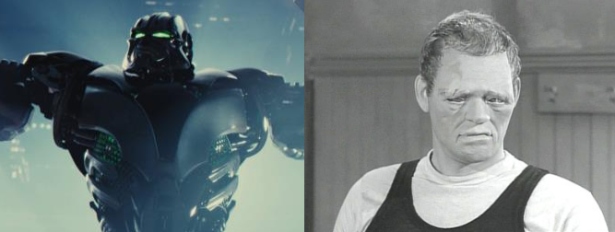Real Steel Was Based on a Twilight Zone Episode, Which Was Based on a Short Story by Richard Matheson
Imagine What You'll Know Tomorrow

Contrary to popular belief, this weekend’s box office winner, Real Steel, was not based on the game Rock ‘Em Sock ‘Em Robots. It was based on a short story, Steel by Richard Matheson, which became an episode of The Twilight Zone featuring Lee Marvin. Matheson also wrote the stories for the classic William Shatner episode, “Nightmare At 20,000 Feet,” and a bunch of other stories you might have heard of: A Stir of Echoes, The Incredible Shrinking Man, and I Am Legend, to name a few. So, how different is Real Steel from Steel?
When something is marketed so heavily as a feel-good family movie that looks suspiciously like a children’s game of the 1980s and not a dark, dystopic science fiction story from the 1950s, it’s easy to write it off. But what are the darker themes of the original 1956 story, which was first published in The Magazine of Fantasy and Science Fiction? We can refer to one Mr. Rod Serling for that. This was the opening narration for the episode:
Battling Maxo is a robot, or, to be exact, an android, definition: ‘an automaton resembling a human being.’ Only these automatons have been permitted in the ring since prizefighting was legally abolished in 1968. This is the story of that scheduled six-round bout, more specifically the story of two men shortly to face that remorseless truth: that no law can be passed which will abolish cruelty or desperate need – nor, for that matter, blind animal courage.
It’s the future — which, back then, was 1974 — and former boxer Steel Kelly is the man who takes the broken-down Battling Maxo’s place in the ring, trying to pass himself off as the robot, only to lose without ever making a dent on his opponent, a more powerful B7 robot. When he’s down for the count, he has to stay there, lest he expose himself as a human and lose any money he might make after the promoter promises half the prize money. So, what’s the moral of the story?
Portrait of a losing side, proof positive that you can’t outpunch machinery. Proof also of something else: that no matter what the future brings, man’s capacity to rise to the occasion will remain unaltered. His potential for tenacity and optimism continues, as always, to outfight, outpoint and outlive any and all changes made by his society…
Obviously, Real Steel, starring Hugh Jackman and Evangeline Lilly and directed by the very family-friendly Shawn Levy, takes a much less cynical route and is more about the relationship between father and son than between man and robot. And that probably helped it reach the top of the box office this weekend — but not with as much money as DreamWorks/Disney had hoped. Though they came in first, Real Steel only brought in $29 million as of today, and they are aiming for more like $125 million throughout its release in order to make a profit (it cost $110 million to make).
You can see Levy discuss the Twilight Zone connection at the LA Times site. But if you’re more interested in the original story and have 25 minutes, you can watch the Twilight Zone episode that inspired the movie right here:
Have a tip we should know? tips@themarysue.com